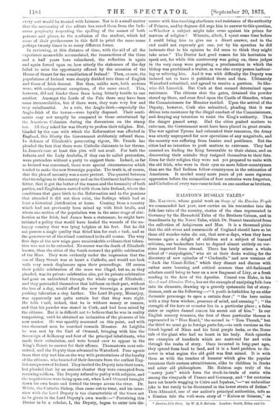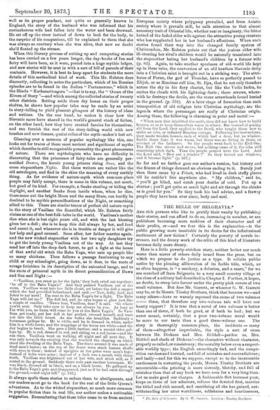RALSTON'S RUSSIAN TALES.*
Mn. RALSTON, whose genial work on Songs of the Russian People we commended last year, now carries on his researches into the folk-lore tales of the country, stories of the class represented in Germany by the Household Tales of the Brothers Grimm, and in Scandinavia by the Norse Tales, which Dr. Dasent translated from the collection of Asbjiirnsen and Moe. It is a thousand pities that the old-wives and nursemaids of England should have so let these old wonder-tales die out, that now-a-days, when they have become again a delight of children and a subject of learned criticism, our booksellers have to depend almost entirely on ver- sions imported from abroad. There has lately arisen a whole school of " storyologiats," who sit at their desks waiting for the discovery of new episodes of " Cinderella " and new versions of "Jack the Giant-Killer," which they dissect and discuss with rather more learning and critical acumen than old-fashioned scholars could bring to bear on a new fragment of Livy, or a fresh reading in the Acts of the Apostles. Consul von Hahn, in his Greek and Albanian Tales, has set the example of analysing folk-lore into its elements, drawing up a gravely systematic list of story- themes, such as the following :—"A youth is forbidden by an older doemonic personage to open a certain door ;" "the hero unites with a tiny form wisdom, presence of mind, and cunning " ; "the strength of the hero or monster lies in a particular place ; a false sister or captive damsel coaxes his secret out of him." In our English nursery romance, the first of these particular themes is represented in "Blue Beard," the second in "Tom Thumb," but the third we must go to foreign parts for,—to such versions as the Greek legend of Nisos and his fatal purple locks, or the Norse tale of the giant who had no heart in his body. Such episodes are examples of hundreds which are scattered far and wide through the realm of story. Once invented in long-past ages, they spread from land to land, and it is a hard problem to dis- cover in what region the old gold was first mined. It is with them as with the touches of humour which give the popular romances their curious attractiveness, alike to children in frocks and sober old philosophers. Mr. Ralston says truly of the "merry jests" which form the stock-in-trade of rustic wits among the vineyards of France and Germany, and "for centuries have set beards wagging in Cairo and Ispahan,"—" an unfamiliar joke is but rarely to be discovered in the lower strata of fiction." Thus Afanasief, one of our author's principal authorities, tells as a Russian tale the well-worn story of "Knives or Scissors," as • Russian Folk-Tales. By W. it. S. Ralston. London: Smith, Elder, and Co.
well as its proper pendant, not quite so generally known in England, the story of the husband who was informed that his cantankerous wife had fallen into the water and been drowned. He set off up the river instead of down to look for the body, to the surprise of his companions, till he explained to them that she was always so contrary when she was alive, that now no doubt she'd floated up the stream.
When this literary process of cutting up and comparing stories has been carried on a few years longer, the day-books of fun and faery will have been, as it were, posted into a huge mythic ledger, and new stories will be sent in with a sort of bill of parcels of their contents. However, it is best to keep apart for students the mere details of this methodical kind of work. This Mr. Ralston does discreetly, collecting in notes the particulars, which of his Russian episodes are to be found in the Italian " Pentamerone," which in the Hindu " Kathasaritsagara "—that is to say, the " Ocean of the Rivers of Story "—and which among the collected stories of twenty other districts. Setting aside these dry bones on their proper shelves, he shows how popular tales may be made by an artist in story-telling to yield pleasant glimpses of the history of ideas and nations. On the one hand, he makes it clear how the Slavonic races have shared in the world's general stock of fiction, on the other hand, how they have created fancies for themselves, and can furnish the rest of the story-telling world with new touches and new themes, quaint relics of the myth-maker's lost art.
Glancing over a museum of popular mythology like this, one looks out for traces of those most ancient and significant of myths which describe in still recognisable personality the great phenomena of nature. There are mythologists who have no difficulty in discovering that the princesses of fairy-tales are generally per- sonified Dawns, the heroic young princes rising Suns, and the cross stepmothers Rights. But these writers are rather like the old astrologers, and find in the skies the meaning of every earthly thing. As for evidence of nature-myth which common-place people may fairly accept, there is some in this volume, not much, but good of its kind. For example, a Snake stealing or hiding the daylight, and another Snake from inside whom, when he dies, there come out the bright Moon and the many Stars, can hardly be doubted to be mythic personifications of the Night, or something allied to this. There are similar traces of perfect old nature-myth in the story of Vasilissa the Beautiful, which Mr. Ralston fairly claims as one of the best folk-tales in the world. Vasilissa's mother dies when she is but eight years old, and with the last blessing gives her a doll ; she is to keep this doll always by her, and feed and cosset it, and whenever she is in trouble or danger it will give her help and good counsel. Soon after, her father marries again, and the new wicked stepmother with her two ugly daughters try to get the lovely young Vasilissa out of the way. At last they send her off into the deep dark forest, to get a light at the house of that awful old witch the Baba Yaga, who eats up people like so many chickens. Then follows a passage fascinating to any child or any ethnologist, going down, as it does, to the roots of savage fetishism in its description of the animated image, and to the roots of primeval myth in its direct personification of Dawn and Sun and Night :—
" 'Vasilissa, you must go for the light,' they both cried out together; be off to the Baba Yaga's!' And they pushed Vasilissa out of the room. Vasilissa went into her little closet, set before the doll a supper which she had provided beforehand, and said Now, dolly, feed, and listen to my need! I'm sent to the Baba Yaga's for a light. The Baba Yaga will eat me !' The doll fed, and its oyes began to glow just like a couple of candles. Never fear, Vasilissa, dear !' it said. 'Go where you're sent. Only take care to keep me always by you. As long as Fin with you, no harm will come to you at the Baba Yaga's.' So Vasi- lissa got ready, put her doll in her pocket, crossed herself, and went out into the thick forest. As she walks she trembles. Suddenly a horseman gallops by. Ho is white, and be is dressed in white, under him is a white horse, and the trappings of the horse are white—and the day begins to break. She goes a little further, and a second rider gal- lops by. He is red, dressed in red, and sitting on a red horse—and tho sun rises. Vasilissa went on walking all night and all next day. It was only towards the evening that she reached the clearing on which
stood the dwelling of the Baba Yoga. The fence around it was made of dead men's bones; on the top of the fence were stuck human skulls. with eyes in them ; instead of uprights at the gates were men's legs; instead of bolts were arms ; instead of a lock was a mouth with sharp teeth. Vasilissa was frightened out of her wits, and stood still, as if rooted to the ground. Suddenly there rode past another horseman. Ho was black, dressed all in black, and on a black horse. He galloped up to the Baba Yoga's gate and disappeared, just as if he had sunk through the ground,—and night fell." (p. 152.)
It always spoils these stories to reduce them to abridgments, and our readers must go to the book for the rest of the little Queen's adventures. As to the wicked stepmother, so much more common in popular fiction than in real life, our author makes a noticeable suggestion. Remembering that these tales come to us from ancient European society where polygamy prevailed, and from Asiatic- society where it prevails still, he calls attention to that almost necessary trait of Oriental life, whether real or imaginary, the bitter hatred of the faded older wife against the attractive young creature who has supplanted her in her husband's affections. When such stories found their way into the changed family system of Christendom, Mr. Ralston points out that the jealous elder wife ill-treating her rival's children would be naturally translated into the stepmother hating her husband's children by a former wife (p. 82). Again, to take another specimen of old-world life kept up in these tales, the conversion of an old heathen Slavonic deity into a Christian saint is brought out in a striking way. The attri- butes of Perun, the god of Thunder, have so perfectly passed to Elijah, or as Russians call him, St. Ilya, that he not only thunders across the sky in his fiery chariot, but like the Vedic Indra, he smites the clouds with his lightning-darts ; these arrows, where- with he destroys the devils, are the stone arrowheads found buried in the ground. (p. 338). At a later stage of formation than such transposition of old religion into Christian mythology, are the legends where the personages are really of Christian origin. Among these, the following is charming in point and moral :—
When men first inhabited the earth, they did not know how to build houses, so as to keep themselves warm iu winter. But instead of asking aid from the Lord, they applied to the Devil, who taught them how to make an izba, or ordinary Russian cottage. Following his instructions, they made wooden houses, each of which had a door, but no window. Inside these huts it was warm, but there was no living in them, on account of the darkness. So the people went back to the Evil One. The Evil One strove and strove, but nothing came of it, the itha still remaining pitch dark. Then the people prayed unto the Lord. And the Lord said, Hew out a window 1" So they hewed out windows, and it became light." (p. 321.) So far and no farther goes our author's version, but history and the fitness of things demand an obvious ending to it. Surely just then there came by a Priest, who had lived in dark stuffy places till he couldn't live anywhere else. "My children," said he, "you'll go blind, and catch your deaths of cold. Put up a shutter ; you'll get quite as much light and air through the chinks as is good for you." So they took his bad advice, and a frowzy people they have been ever since, body and soul.































 Previous page
Previous page